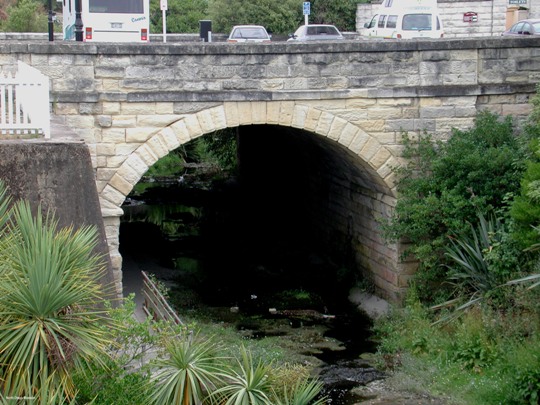The Thames Street Bridge, built in 1861 and widened in 1876, links Oamaru’s harbour precinct with the main thoroughfare through the town. The bridge has special historical and architectural significance, being one of the earliest limestone structures built in Oamaru and one of the widest bridges in the country at the time it was built. The fledgling settlement around the beach landing service in the shelter of Cape Wanbrow grew up in the late 1850s, where H.C. Hertslet built an accommodation house. The town survey was submitted to the Waste Lands Board in February 1859, setting the pattern for the future Oamaru. The grid pattern made only ‘occasional concessions’ to the lie of the land. The first survey was confined to the south of Oamaru Creek, and as the town developed, the creek became a formidable barrier. People crossed the street on planks and drays forded the creek near Steward Street. Oamaru Creek was a barrier to the Provincial Government’s roading plans for a northern route. On 4 December 1860, the Provincial Government accepted the £1252 tender from John Roy. At the end of 1860, contractors began building the substantial bridge on the line of Thames Street. The contract specified Greystone from the hill near the Casa Nova property, but the contractors could not find large enough blocks, so requested permission to use limestone from near Awamoa. The stone bridge had a span of 24 feet [7.3 metres] and was 18 feet [5.5 metres] wide. In 1869, footpaths with wrought iron railings were added to the side of the bridge. Early photographs show the single arch bridge with rough faced stone, with a narrow pedestrian bridge on its upstream side. The increasing traffic and the development of the business centre to the north of Oamaru Creek led to calls to widen the bridge. The North Otago Times lobbied the Provincial Government and the Municipal Council, describing the bridge’s ‘absurd narrowness, little better than a dangerous obstruction to the traffic along our main thoroughfare.’ By August 1875, the Provincial Government had voted £500 towards widening the bridge, and there were hopes that the council would contribute towards the cost. After some debate, the council decided that the bridge should be widened to the ‘full width of the street and pathway on each side.’ In February 1876 the town clerk called for tenders for the ‘Masonry and other works connected with the widening [of the] Thames Street Bridge’. The Council accepted the £1061 tender of Barclay and Kay. The tender was for the use of the Corporation Quarry stone, but later discussion permitted the contractors to use the ‘best Cave Valley stone’ with the approval of the surveyor and the Public Works Committee and with an appropriate reduction in price. The widening completed, the townspeople were proud of the substantial bridge – a full 2 chains wide – recognised at the time as the widest bridge in New Zealand, although among the shortest. Later reports identified it as the widest bridge in the Southern Hemisphere until the Sydney Harbour Bridge opened. The widened bridge was 40.24 metres wide and with a span of 7.32 metres. It is built of limestone, with a textured finish. The deck supports the road, flanked by footpaths. The Thames Street Bridge is adjacent to Oamaru’s first Post Office. It has an unassuming street presence. It is higher on its seaward side, and there is a slight dogleg in the south parapet. Some stones are marked with the chisel with others are dressed. There is pedestrian access on a riverside path beneath the bridge that allows people to see the detail of its construction. In 2015, the Thames Street Bridge remains the main connection between Thames Street and the Harbour/Tyne precinct.

Location
List Entry Information
Overview
Detailed List Entry
Status
Listed
List Entry Status
Historic Place Category 1
Access
Private/No Public Access
List Number
2305
Date Entered
12th December 1990
Date of Effect
12th December 1990
City/District Council
Waitaki District
Region
Otago Region
Extent of List Entry
Extent includes part of the land described as Legal Road, Otago Land District, and the stone structure known as the Thames Street Bridge, thereon. Refer to the extent map tabled at the Heritage New Zealand Board meeting on 3 September 2015.
Legal description
Legal Road, Otago Land District.
Stay up to date with Heritage this month
